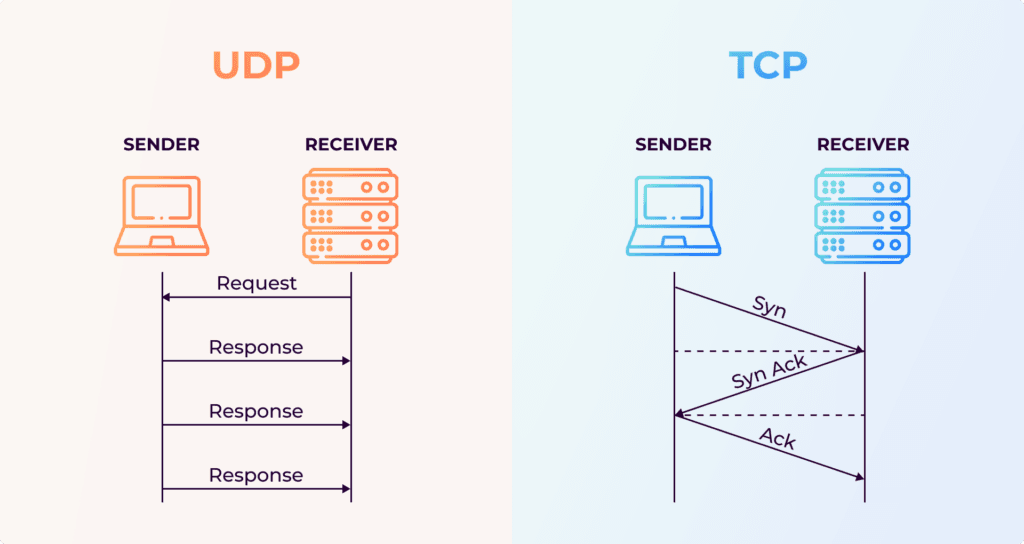🧠 What Are Internet Protocols?
Imagine trying to send a letter 📬 to your friend in another city. You need rules:
- How to write the address
- What language to use
- Where to post it
These rules make sure your letter reaches safely.
On the internet, protocols are similar rules. They define how data is sent, received, and understood between computers. 🖥️➡️📡➡️🖥️
🔒 Why Are Protocols Important?
Without protocols, your computer wouldn’t know:
- Where to send the message
- How to read the response
- How to keep the message safe
Protocols ensure reliability, accuracy, and speed.
🔗 4.1 TCP/IP – The Backbone of the Internet
⚙️ What Is TCP/IP?
TCP/IP stands for Transmission Control Protocol / Internet Protocol.
It’s like the postal service of the internet:
- IP finds the destination (like a house address)
- TCP makes sure the package (data) gets there safely

✉️ How TCP Works
Think of TCP like a phone conversation 📞
- You say “Hello” ➡️ Connection established
- You speak in sentences ➡️ Data is split into segments
- If the person doesn’t hear, you repeat ➡️ Retransmission
- You say “Bye” ➡️ Connection closed
🔍 Key TCP Features:
- Data Segmentation 📦: Breaks big files into small chunks
- Error Checking ✅: Makes sure data isn’t corrupted
- Retransmission 🔁: Resends missing parts
🗺️ What Is IP (Internet Protocol)?
IP handles routing—deciding where data goes.
Every device online has an IP address like 192.168.0.1. Just like a home address! 🏠
Example:
- You type
webcodder.dev - DNS finds the IP address
- IP sends the data there
🔢 What Are Port Numbers?
Ports tell your computer which app or service should handle the data.
- Port 80: Websites (HTTP)
- Port 443: Secure websites (HTTPS)
- Port 25: Email (SMTP)
Think of IP as the building 🏢 and Port as the room number 🚪
🧳 Datagram Transmission
Each data packet is called a datagram.
TCP ensures they:
- Reach in order
- Are not lost
- Are complete
⚡ 4.2 UDP – Fast but Risky
🚀 What Is UDP?
UDP stands for User Datagram Protocol. It’s like sending postcards:
- No guarantee of delivery 📮
- No tracking
- But super fast ⚡
🎥 When Do We Use UDP?
UDP is perfect when speed matters more than accuracy:
- Video streaming 🎬
- Live games 🎮
- VoIP calls 📞
If a few data packets are lost, it’s okay. You don’t want buffering just to correct a tiny error!
🥊 TCP vs UDP – A Quick Comparison
| Feature | TCP | UDP |
|---|---|---|
| Reliability | ✅ Yes | ❌ No |
| Speed | 🚶♂️ Slower (safer) | 🏃♂️ Faster (riskier) |
| Use Case | Websites, Emails 📧 | Videos, Games 🎮 |
| Data Order | ✔️ Ordered | ❌ Not guaranteed |
| Overhead | 📦 Heavy | 🪶 Light |
🧠 Key Concepts Recap:
- TCP/IP ensures safe and ordered delivery.
- UDP is fast, great for real-time.
- IP Addresses and Ports route the traffic.
- Protocols are the language of the internet.
🎓 Infographic: TCP vs UDP Flow
4. Internet Protocols Made Easy 4
📌 Final Thoughts
Protocols are the invisible helpers behind every Google search, YouTube video, or WhatsApp message.
They make sure your data gets where it needs to go—fast, safe, and in the right format. 🌐
❤️ Want to Learn More?
👉 Subscribe on YouTube
👉 Read More on Automation
👉 Join Us on WhatsApp
🎯 Got questions? Drop a comment or ping me. Let’s decode the web together! 💡




